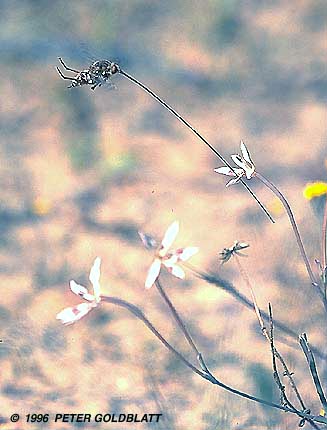Posted by jorgemotalmeida on 05-01-2010 19:20
#26
Forget that guy... we don't need it. :P
Thanks a bunch, Vida. (Life in Portuguese :) I will wait with anxiety for my mythicos. :) Another thing: look out for nemestrinids and bombyliids (one of the best countries in the world for these families!). The fly with the longer proboscis in all Diptera world is in... SA! Its proboscis reaches 90 to 100 mm in length, this being the longest proboscis of all known Diptera! And it is a nemestrinid. I put that info somewhere here in DI.
Found it! Here:

see here other photos:
http://www.natura...ngirostris
it is Moegistorhynchus longirostris (Nemestrinidae). More on this fly can be read here:
http://www.bioone...08.00547.x
I transcribed here the text because the site can disappear, so here is:
"The idea of coevolution originated with Darwin's proposal that long-proboscid pollinators and long-tubed flowers might be engaged in reciprocal selection, but this has not been demonstrated. Here we test key aspects of Darwin's hypothesis of reciprocal selection in an experiment with naturally interacting populations of extremely long-proboscid flies (Moegistorhynchus longirostris: Nemestinidae) and long-tubed irises (Lapeirousia anceps: Iridaceae). We show that the benefit derived by both the fly (volume of nectar consumed) and the plant (number pollen grains received) depends on the relative length of their interacting organs. Each trait is shown to act both as agent and target in directional reciprocal selection, potentially leading to a race. This understanding of how fitness in both species varies in relation to the balance of their armament allows us to make tentative predictions about the nature of selection across multiple communities. We find that in each community a core group of long-tubed plant species might together be involved in diffuse coevolution with the fly. In poorly matched populations, the imbalance in armament is too great to allow reciprocal selection to act, and these species might instead experience one-sided selection that leads to convergence with the core species. Reciprocal selection drives the evolution of the community, then, additional species become attached to the network of interacting mutualists by convergence."
Hopefully you know that flower! If so, please go find that fantastic nemestrinid feeding and hovering on that iris! :)
Finally if you are really interested to know more on this read this all:
http://findarticl...n13606619/
Edited by jorgemotalmeida on 06-01-2010 00:43